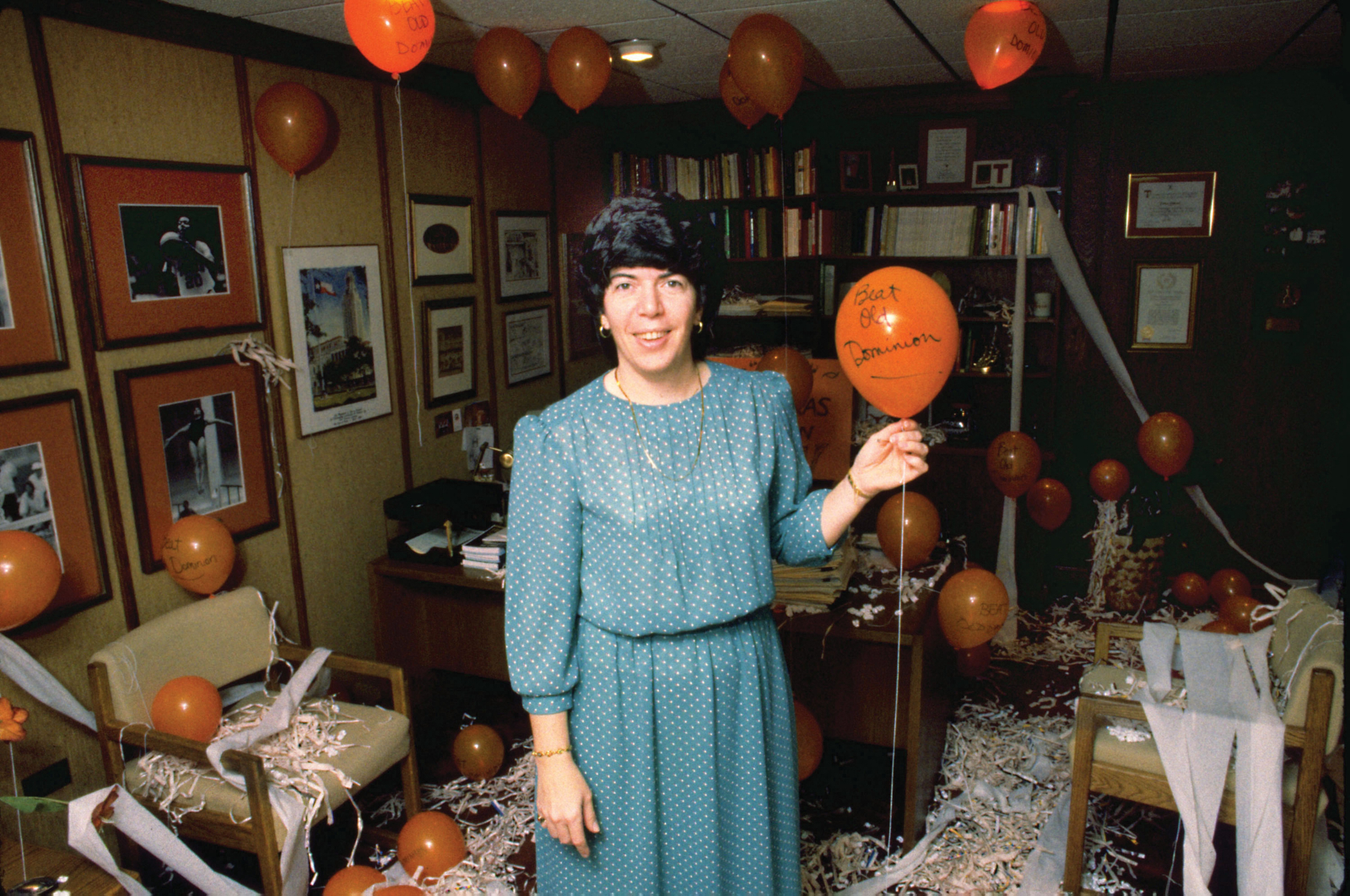How Title IX Helped Level the Playing Field

When the Anna Hiss Gymnasium opened at The University of Texas in 1931, it broke barriers as the first space on campus dedicated to women’s sports. The facilities were grand, with state-of-the-art pools, an outdoor courtyard, fireplaces, and two gymnasiums purposefully designed 6 feet short of regulation to discourage spectators. Inside the building, women could dance and swim and engage in other physical activities. But they couldn’t compete.
Over the next four decades, access for female students improved slightly, but it wasn’t until June 1972 and the passing of Title IX that schools across the nation were required to provide equal opportunities for both men and women in athletics. The law’s passing charted the university on a somewhat bumpy course toward achieving equity in sports, one that would have UT spotlighted as a shining example of how to run a women’s athletics program only to stumble from that pedestal amid a headline-grabbing lawsuit.
As the passing of Title IX reaches its 50th anniversary, some of the pioneers who shaped UT Athletics reflect back on the landmark law, including Jody Conradt, who guided women’s basketball through three decades and an NCAA championship as UT’s first-ever full-time women’s coach.
While the federal law prohibits discrimination based on sex in education programs or activities that receive federal financial assistance, it was missing a key element: money. Title IX guaranteed equal footing for all student-athletes, but it did not give equal funding, instead leaving that up to the schools.
“Title IX was a federal mandate for equity and non-discrimination,” says Chris Plonsky, chief of staff and executive senior associate athletics director, “but without a funding advisement. And remember, Athletics even today are self-sustaining—so back then Darrell [K Royal], who was athletic director and football coach … had the responsibility to fund football.”
Both before Title IX and after, the responsibility for funding sports programs fell to Texas’ directors, coaches, staff, and boosters, who had to convince donors to fork over big bucks. But without discrediting what was surely an immense amount of work by Royal, when you coach football for 21 years, and you’ve never had a losing season, and you’re so revered they eventually name a stadium after you, fundraising for football is arguably an easier task than, say, finding money for a women’s soccer team.
By 1993, more than 20 years after Title IX’s historic passage, UT had created “one of the nation’s most successful and respected women’s athletic programs,” as the Washington Post put it in an article four years later. From the inside, the playing field was not even, however, at least according to then-Women’s Athletic Director Donna Lopiano.
Lopiano had been hired by Lorene Rogers, UT’s first—and only—female president, to help build the department in the wake of Title IX.
“Her primary goal was to build women’s athletics and promote women’s athletics and to build teams and build a fan base,” says Conradt, who joined Lopiano’s department in 1976. Though Conradt had grown up playing basketball and spent her career coaching it, she was originally asked to coach both basketball and volleyball—a sort of two-for-one deal.
In addition to sharing a coach, the squads also shared uniforms. “[Lopiano] had ordered basketball uniforms, and they came before the fall semester started, which is the volleyball season. She decided that the volleyball team could wear them first. I don’t think the basketball team ever got over that,” Conradt laughs.

Two decades after Title IX was passed, Lopiano felt the university still wasn’t giving equal opportunities to men and women. Before leaving the university to run a nonprofit in 1992, Lopiano reportedly connected the women’s rowing coach with an Austin attorney. A few months later, a lawsuit was filed against UT by seven of its female athletes.
Plonsky was in Rhode Island, having left UT to take a job with the Big East, when she heard about the suit. “I heard this news while I’m in Providence … and I was like, that’s crazy because there is no one more committed to athletics than Texas was while I was there. They were the leading public institution in terms of how to do women’s athletics right. But again, this was about numbers and the number of people on men’s teams and women’s.”
By the summer of 1993, the university had settled. “They settled the case by saying, yes, we need to put more opportunities and scholarships in women’s athletics, and to add three sports: soccer, softball, and rowing,” Plonsky explains.
Shortly after the lawsuit was settled, Deloss Dodds, who served as athletic director from 1981 to 2013, called Plonsky and asked her to return to Austin. He and Conradt had a plan to combine men and women’s athletics’ communications and marketing, Dodds told Plonsky, and they wanted her on the team.
“We want one voice,” Dodds told Plonsky, who returned shortly after as an associate athletic director. It was the first time the two departments would join forces.
Also part of the plan was establishing softball as one of the school’s three new sports, which was a requirement as part of the lawsuit agreement. For the first few years, the team competed on a city-owned field in East Austin, until Conradt and a feisty development colleague named Jan Hughes took a drive down to San Antonio to meet with Red McCombs. A few weeks earlier, Hughes had been seated next to McCombs at a dinner. The two began talking and she mentioned she was in development for women’s athletics.
Who’s your biggest donor? McCombs asked.
We don’t have one, she said, which is how Hughes and Conradt ended up sitting in McCombs’ office a short while later.
In between spinning yarns, McCombs asked the women what they would do with $3 million. Build a softball facility, Conradt replied. McCombs agreed to the donation—women’s athletics’ largest at the time—and the Red & Charline McCombs Field opened in 1998. Its creation was such a career milestone for Hughes that it was later included in her obituary.
The facility paid off almost instantly. Before it was even finished, McCombs Field landed UT softball one of the nation’s top athletes: Christa Williams, a prolific pitcher, returned to Texas after receiving a scholarship at UCLA and helped get UT to the College World Series in 1998. It was the first of five College World Series championships in which the UT softball team would make an appearance.
It would be nice to say that 50 years later, women’s athletics has found an equitable balance to that of men’s, but that would be unfair and untrue. Women’s basketball drew dismal attendance numbers this season, averaging only 2,757 fans per game despite their 29-7 record, according to the Austin American-Statesman, and proving that 80 years after the Anna Hiss Gymnasium opened, society still struggles to view women as competitors.
Now the squad will play in the new Moody Center, which should hopefully boost attendance as fans flock to see the new facility. But as they jog onto the court for their first game, some athletes may not realize that Title IX is the reason they even get to suit up at all.
“Some of those people who experienced [discrimination]—and it was women, it was minorities—all those people are dying off and these stories are important for us to move forward,” Conradt says. “We can’t lose sight of the fact that those were rights that were hard-earned and diligently fought for.”






